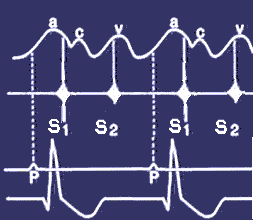| Heart Sounds & Murmurs | | | Liver & Ascites | | | [Neck Veins] | | | Pulmonary | | | Thyroid |
|
[Skill Modules
>>
Neck & Veins Examination
>>
Techniques
]
Techniques: Jugular Venous Wave Form AnalysisIdentifying jugular venous wave forms gives you a clue as to heart function and also allows for diagnosing arrhythmias at the bedside.There are two important waves: a wave & v wave
Neck vein wave forms have a gradual upslope and a dramatic collapse. This is the exact opposite of the carotid, which have a dramatic upslope and a gentle collapse. Because the collapse in neck veins is the most dramatic movement , it is what you time when you are trying to determine what type of wave it is:
How do you time which is x descent and which is y descent?
The easiest way is to time it with S2.
Many cardiologists just time it with the carotid.
Historical Note: The waves were named by James McKenzie. He thought that the C wave was from the carotid, so named it "C". |
||||||||||||||||||||||||

